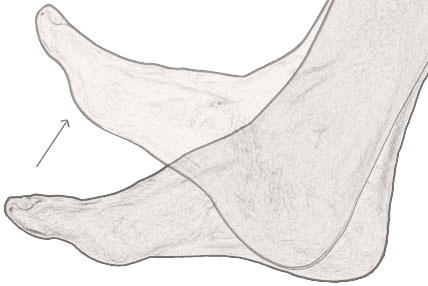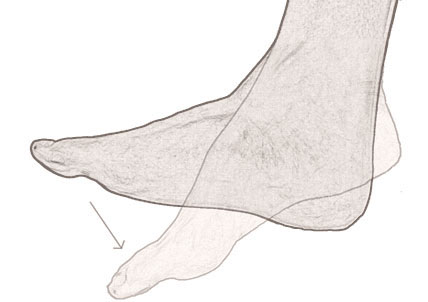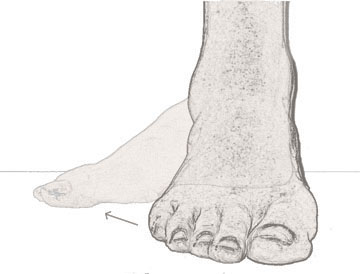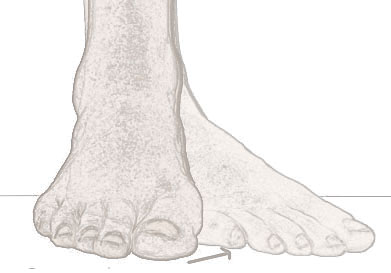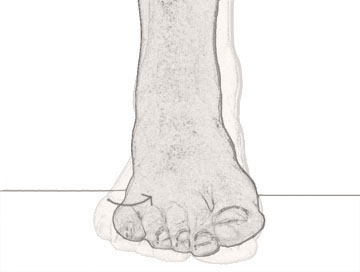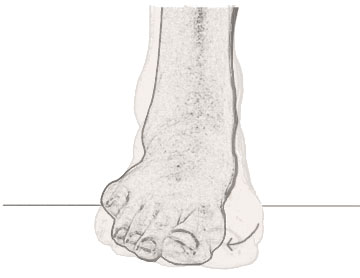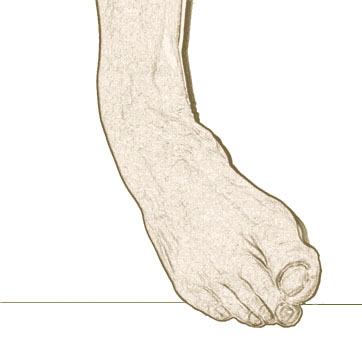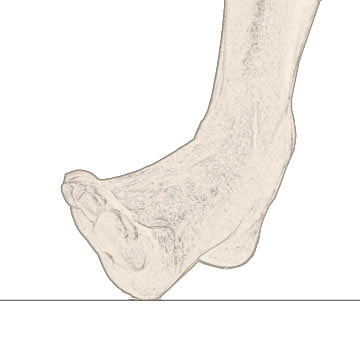Remember that these adjustments can be applied to either orthotic (left/right) please specify the foot on the questionnaire included in the impression kit. See diagrams below for terms / definitions or seek professional guidance from your local podiatrist / physical therapist.
1. Full Length Varus Wedge:
Ramps the entire length of the insole on the medial side (side of foot with the big toe). Adjustment range: 0-3 degrees. Helps correct over pronation
2. Full Length Valgus Wedge:
Ramps the entire length of the insole on the lateral side (side with the small toe). Adjustment range: 0-3 degrees. Helps correct over supination.
3. Arch Support:
Reduces or increases the amount of support under the arch area of the foot. Adjustment range: -30 to +30 percent.
4. Heel Lift:
Increases the thickness under the heel with a linear ramp placed from the ball of the foot to the heel. Adjustment range: 0-12mm
5. Metatarsal Pad:
Places a standard metatarsal pad just distal (at the end) to the metatarsal heads. Adjustment range: 3-6mm
6. Heel Cupping:
Increases or reduces the heel cup of the orthotic. Adjustment range: -30 to +30 percent.
7. Medial Heel Wedge:
Posts the medial side (side with big toe) of the rearfoot. Adjustment range: 0-6 degrees.
8. Lateral Heel Wedge:
Posts the lateral side (side with small toe) of the rearfoot. Adjustment range: 0-6 degrees.
9. Medial Forfoot Wedge:
Wedges the medial side of the forefoot. Adjustment range: 0-6 degrees.
10. Lateral Forefoot Wedge:
Wedges the lateral side of the forefoot. Adjustment range: 0-6 degrees.
Foot Biomechanics: Terms & Definitions
"Bio" means life or living organism. "Mechanics" is the original discipline of physics as it applies to forces on matter. For our purposes, biomechanics is defined as the mechanics of the human body, especially the forces of the muscles and gravity on the skeletal structure of the lower extremity.
Foot Terminology: Anatomic terms for location of body parts and motions are necessary for a variety of reasons. We can not simply say "outside of the toe" because not everyone will agree on which part of the toe is the "outside." Although it may seem simple to refer to the "top of the foot", as soon as the foot moves or is rotated or has a deformity, the top of the foot is no longer on top. Medical professionals need a uniform way to describe both locations and movements.
|
Definitions: Anatomic Locations Lateral means away from the center line of the body. Distal means further from the body. Proximal means closer to the body. Anterior means the front of the body Posterior means the back of the body Dorsal means the top of the foot Plantar means the bottom of the foot | 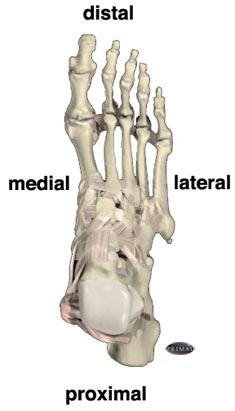 |
|---|
Looking at the foot diagram above, the big toe is medial and the little toe is lateral. The toes are distal to the midfoot and the midfoot is distal to the heel bone. The heel bone is proximal to the toes. The toes are also considered anterior to the midfoot and the heel sits posterior to the midfoot.
Definitions: Motions of the foot and ankle
Supination and Pronation
Supination and pronation are a combination of the above motions. It is common to use supination and inversion interchangeably and pronation and eversion interchangeably. But, supination is actually a combination of inversion, plantarflexion and adduction. Pronation is a combination of eversion, dorsiflexion and abduction.
To better understand supination, look at the right foot in the image below. The heel rotates towards the center of the body, the big toe moves towards the center of the body, the foot flexes down and the ankle rolls out.
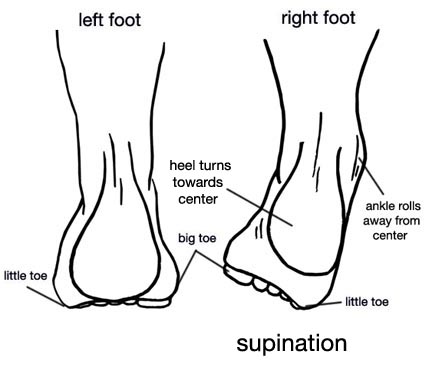 |
|---|
To better understand pronation, look at the right foot in the image below. The heel rotates away the center of the body, the little toe moves away from the center of the body, the foot flexes up slightly and the ankle rolls in.
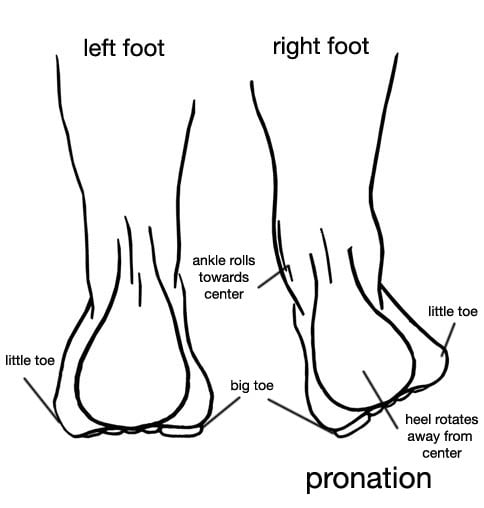 |
|---|
To understand these motions while standing, try this with your own feet. Stand with your feet parallel and facing foward. Rotate your body and look over your left shoulder, without moving your feet. Your left leg has rotated out (external leg rotation) and your weight will be on the outside of your left foot. Your left foot is supinated. Your right leg has rotated in (internal leg rotation) and your weight is on the inside of your right foot. Your right foot is pronated.
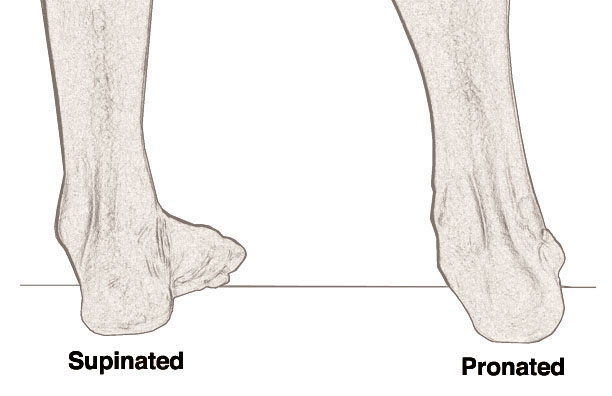 |
|---|
|
Gait Cycle Contact: The beginning of the gait cycle is marked by the heel contacting the ground. This is called heel strike. Forefoot contact: The forefoot contacts the ground, stabilizing the foot and the body. Midstance: When the weight of the body is directly over the foot. The opposite foot is swinging from the rear of the body towards the front of the body. Heel off: When the heel starts to lift from the ground, the weight shifts to the front of the foot. The opposite foot has made contact with the ground. Push off: Also called toe off and propulsion, this phase is the terminal stance phase of the gait cycle, which means that the foot is pushing off the ground and will be entering the swing phase (swinging from the rear of the body to the front of the body). During the normal gait cycle (normal walking) the feet supinate and pronate. It's important to understand that pronation is a normal motion when walking. When the feet pronate too much, this is when people experience problems like plantar fasciitis, tendonitis and painful arches. An abnormal amount of supination can cause also cause problems. When the foot supinates too much people may develop tendonitis and joint problems at the forefoot and big toe joint. |
|---|
Disclaimer: The advice on this website is not intended to substitute for a visit to your health care provider. We will not be held liable for any diagnosis made or treatment recommended. Consult your doctor if you feel you have a medical problem.

